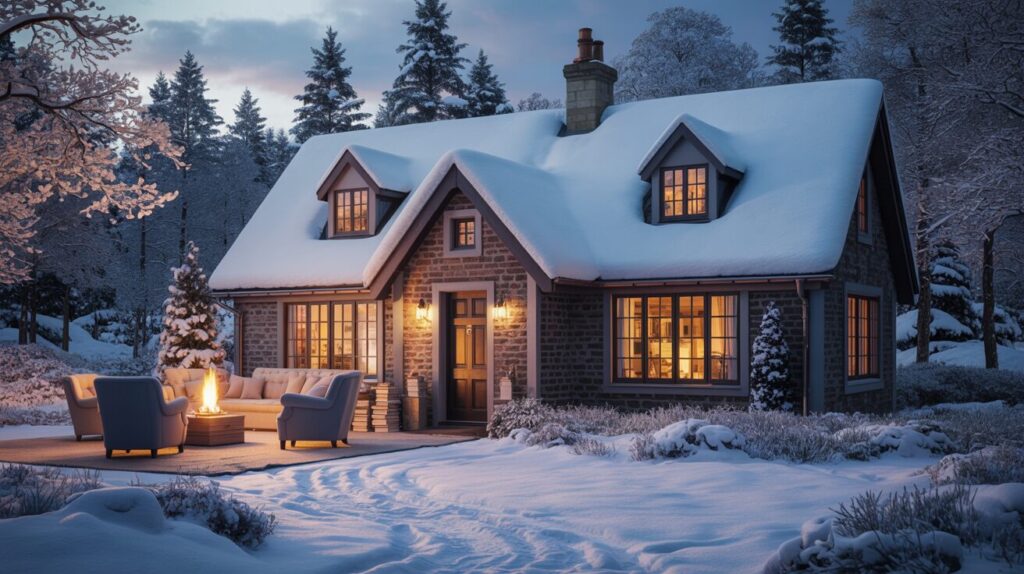You can save a lot of money on winter heating bills and help the Earth too. Switch to heat pumps that use much less energy than gas heaters. Add better insulation made from recycled materials or natural wool. Fill air gaps with caulk and weather strips to stop cold air from getting in. Smart thermostats can cut your energy use by 23% by adjusting the temperature by themselves. Solar panels can power your heating system all year long. These simple steps will keep you warm without incurring excessive costs or harming the environment.
Switch to Energy-Efficient Heat Pumps for Maximum Savings
While traditional gas boilers gulp energy like a thirsty elephant, heat pumps sip it like a hummingbird—using up to six times less energy to heat your home. These sustainable heating systems extract thermal energy from outdoor air or ground sources, then concentrate it indoors through a refrigeration cycle. You’ll slash your energy consumption dramatically while accessing renewable energy sources year-round. Heat pumps reverse their operation for summer cooling, making them versatile eco-friendly solutions. Though upfront costs seem steep, government subsidies and massive energy savings quickly offset installation expenses, helping you reduce your carbon footprint without sacrificing comfort.
Improve Your Home’s Insulation With Sustainable Materials
Your air conditioning system needs two fan motors that work together to keep your home cool. The indoor fan pushes cool air through your ducts, and the outdoor fan removes heat from the refrigerant coils. They work as a team – one brings you cool air, the other gets rid of hot air outside. When these motors break down, you’ll get less air flow or warm air from your vents. Knowing how these two fans work together helps you figure out which one is causing your comfort problems.
Choose Sustainable Insulation Materials
When upgrading your home’s insulation, sustainable materials can deliver the same thermal performance as traditional options while dramatically reducing your environmental footprint. Recycled cellulose insulation, made from old newspapers, offers excellent heat loss prevention while keeping waste from landfills. Sheep’s wool naturally regulates moisture and provides superior energy efficiency—think of it as nature’s thermal blanket. Cork insulation resists pests and fire while maintaining Energy Star-level performance. These eco-friendly choices reduce your energy consumption by 30-50%, slashing energy bills considerably. They’re environmentally friendly alternatives that work beautifully with renewable energy sources like solar panels.
Insulate Key Home Areas
The biggest heat losses in most homes happen in three critical zones that function like open windows in winter: your attic, basement or crawl space, and exterior walls. You’ll want to insulate these areas first to maintain indoor warmth effectively. Start by sealing air leaks with caulk or weatherstripping—think of them as energy thieves stealing your heating costs. Choose sustainable materials like recycled cotton or sheep’s wool for thermal protection that doesn’t harm natural resources. Proper insulation in these key zones creates an energy-efficient barrier, helping reduce waste while slashing your energy consumption markedly.
Seal Air Leaks Properly
Our local experts specialize in thermostat installation, working Air leaks work like tiny saboteurs throughout your home, quietly stealing warmth and driving up heating costs even after you’ve installed quality insulation. You’ll need to seal air leaks around windows and doors using caulk for small cracks and weather stripping for larger gaps. This simple step helps prevent heat loss while heating your home this winter. Try the candle test—hold a lit candle near suspected leak areas and watch for flickering flames. These energy-efficient fixes reduce energy consumption considerably, helping you save energy, stay warm, and save money on your energy bills through better insulation.with top thermostat brands like Google Nest, Ecobee, Honeywell, and Carrier.
Harness Solar Energy to Power Your Heating System
Since sunlight hits your roof every day anyway, why not put it to work heating your home? Installing solar panels transforms your roof into a renewable energy powerhouse that’ll reduce reliance on fossil fuels while cutting your heating bills.
Here’s how solar energy can revolutionize your heating system:
As a homeowner, you’ll dramatically reduce greenhouse gas emissions while saving money on heating and cooling costs year-round.
Seal Air Leaks and Upgrade Windows for Better Heat Retention

While you’re generating clean energy with solar panels, drafty windows and sneaky air leaks can undermine your heating efficiency by letting precious warm air escape. Think of your home like a leaky bucket—you can’t fill it no matter how much water you pour in.
Start by conducting a simple candle test around windows and doors. A flickering flame reveals air movement. Seal air leaks using caulk for small cracks and weather stripping for larger gaps. This immediately improves heat retention while reducing energy costs.
Upgrade windows to double-glazed models for superior insulation and year-round comfort.
Use Smart Thermostats to Optimize Your Heating Schedule
Everyone knows the frustration of coming home to a freezing house or waking up to sky-high energy bills because your heating system ran all night. A smart thermostat solves this by learning your schedule and adjusting temperatures automatically, reducing energy consumption by up to 23%.
Smart thermostats eliminate temperature guesswork by automatically learning your daily routine and cutting energy costs by nearly a quarter.
Here’s how to optimize your heating schedule:
This energy-efficient investment supports your sustainable lifestyle while maximizing comfort.
Layer Up and Lower Your Thermostat Without Sacrificing Comfort
Although dropping your thermostat a few degrees might sound like a recipe for chattering teeth, layering your clothing strategically can keep you just as warm while slashing your heating bills by 10-15%. When you layer up with thermal base layers, sweaters, and wool socks, you’re creating personal insulation that traps body heat. This approach lets you lower your thermostat to 65-68°F without sacrificing comfort. Think of yourself as a walking energy-efficient system—you maintain warmth while reducing heat loss throughout your home. This simple strategy cuts energy consumption considerably, making your renewable energy investment even more effective.

Frequently Asked Questions
What Government Rebates Are Available for Eco-Friendly Heating Upgrades?
You’ll find government subsidies for heat pumps, tax credits for solar panel installations, and financial incentives for energy-efficient upgrades. Countries like Germany and the USA offer rebates to offset costs.
How Much Can I Realistically Save on Winter Heating Bills Annually?
You’ll realistically save 20-40% on winter heating bills annually through eco-friendly upgrades. Proper insulation, sealing air leaks, and heat pumps can reduce costs by $200-800 yearly, depending on your home’s size and current efficiency.
Are There Eco-Friendly Heating Solutions Suitable for Rental Properties?
You can use portable space heaters, heat control window films, weather stripping for air leaks, layered clothing, warm beverages, and humidifiers. These don’t require permanent modifications and you’ll save on heating costs.
Which Heating Methods Work Best in Extremely Cold Climates Below Freezing?
You’ll need heat pumps and triple-glazed windows in sub-freezing temperatures. Layer clothing extensively, use high-efficiency space heaters for targeted warming, and confirm you’ve sealed all air leaks completely for maximum heat retention.